

Generally speaking, it’s time to repot the plant only when it expands its roots and becomes root-bound. If the plant is starting to grow roots out of the drainage holes, it’s definitely time to repot it. You can also check if the plant has outgrown its container by popping the plant out of the pot. If the roots are very prominent and take up the majority of the pot, your plant needs a bigger container.
Therefore, there’s no set rule for repotting your plant. Some plants, like golden pothos or pancake plants, for example, will need repotting every year because they grow very fast. Other plants, namely hoyas or jade plants, develop root systems very slowly and will probably not need repotting for years.

It’s good practice to leave your plants in a nursery pot once you bring them home. This is because transporting the plant into a new environment (in this case, your home) is stressful for the plant, and you don’t want to cause even more stress for the plant by repotting it.
So just let your plant adjust to your home climate first, and repot a month or two later. As mentioned above, it all depends on the plant’s root system. Some of your new plants may only need repotting a year later.
As you wait for your plants to adjust to their new home and grow big and strong, you can always put them in a pretty decorative pot (called a cache pot) of your choosing. This way, you don’t have to compromise on the aesthetic factor.
Related Article: What Problems Do Plant Owners Encounter in the Winter?
First things first, let’s disambiguate between these two terms. While they’re often used interchangeably, a pot is usually a smaller, often round plant container, whereas a planter is a larger, often square, or irregularly-shaped container that’s often placed outdoors and can house several types of plants. For all intents and purposes, plant pots and planters have the same function, so we won’t distinguish between the two further on in the article.

The most important feature of any plant container is a drainage hole. This allows any excess water to flow out of the pot and into a saucer when you’re watering the plant. If you intend to put a plant directly in a pot without drainage holes, it will eventually develop root rot and die.
Therefore, make sure that all of your planters have at least one drainage hole. You can also make a drainage hole in a decorative pot (or any container you want, really) yourself by drilling a hole in it. Many garden centers also offer this service on-site, often free of charge when you purchase a plant.
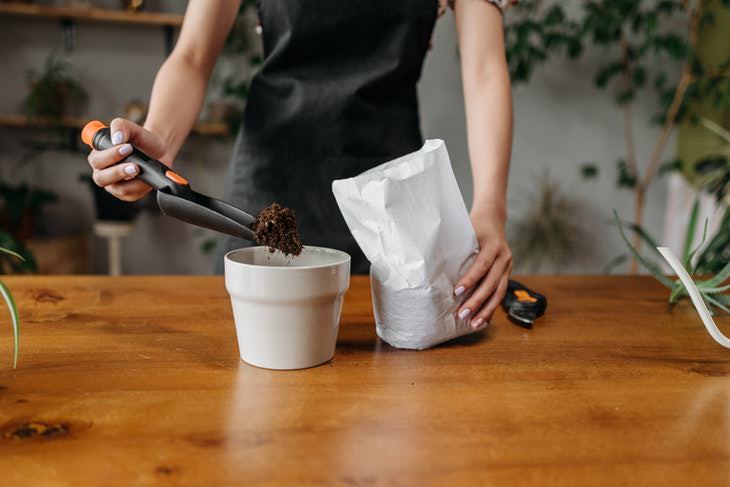
The size of the pot matters a lot as well. Contrary to popular belief, you shouldn’t repot a plant in the biggest container you can if you want it to grow large. Plants are not goldfish, they need a pot just the right size to grow healthily. When you repot into a container that’s too large, a big amount of the surrounding soil will stay moist, drowning the roots and possibly even causing root rot.
Most plants prefer a snug fit. So when you size up your planter, choose a pot that’s 1-2 inches (2.5-5 cm) larger in diameter for small plants or 2-3 inches (5-7.5 cm) bigger for plants that currently live in containers that are larger than 10 inches (25 cm) in diameter. Typically, pots are sold in size differences of 2 inches (5 cm). This size measures the diameter of the pot, not how tall it is. So, if your plant is currently in a 4-inch pot (10 cm), it’s best to size up to a 6-inch (15 cm) one the next time you decide to repot it.
Related Article: Increasing Humidity for Your Houseplants
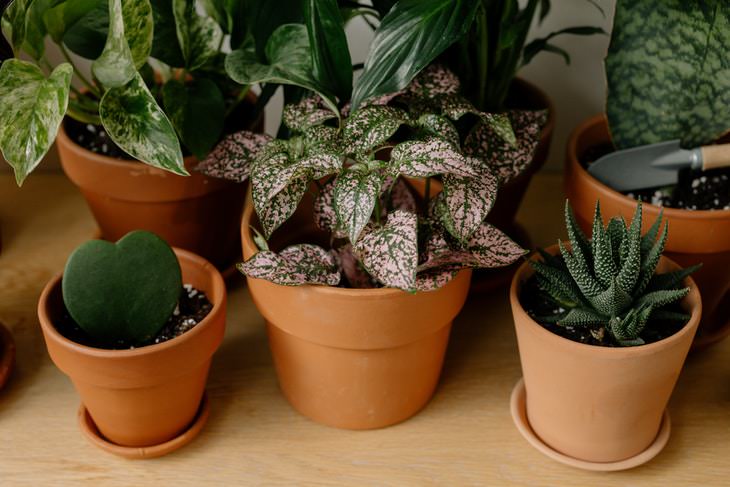
Terracotta pots are renowned for their organic look, accessibility, and relatively low price point. These pots are made of iron-rich clay, which gives them a reddish hue. Unglazed clay is a porous and absorbent material that will absorb excess water from the soil, protecting the plant’s roots from excessive moisture. Therefore, terracotta pots are a good choice for you if you tend to overwater your houseplants. Terracotta plants are also beneficial for plants that prefer to dry out in-between watering, such as cacti, succulents, and tropical vines like some philodendrons or pothos.
That being said, terracotta planters are not ideal for plants that require a lot of moisture, such as ferns. They are also not a good fit if you tend to forget to water your plants, as the soil in terracotta pots will dry out faster. One last disadvantage of terracotta pots is that they are relatively fragile and can crack or dry out when kept outdoors, especially when exposed to extremely hot or cold temperatures.
Also keep in mind that terracotta absorbs mineral salts from the water or fertilizer, which will create white build-up on the pot over time. Some people like this rustic look, whereas others don’t enjoy it as much and will have better luck with glazed ceramic pots.

Ceramic pots share many of terracotta’s characteristics: accessibility, versatility, and aesthetic appeal. They too are made of clay, after all. However, ceramic pots are glazed both inside and out, which makes them hold water more effectively. This makes ceramic pots more durable too. In fact, high-quality ceramic planters can last for decades.
Furthermore, all types of indoor plants tend to fair well in ceramic pots, even those that require a bit more maintenance and care. Also, note that glass pots share all of the characteristics of glazed clay pots, but glass pots with drainage holes are more difficult to come by.
That being said, keep in mind that all clay pots - be it terracotta, or ceramic - tend to retain heat. This can be beneficial if you live in a cooler climate. However, people who live in hotter climates and keep plants in a sunny place outdoors may find that the excessive heat is burning the roots of their plants and killing them. Also note that repotting a plant from a ceramic pot may be tougher than, let’s say, plastic because the material is not pliable, so getting the plant out of the old pot may be a bit more challenging.
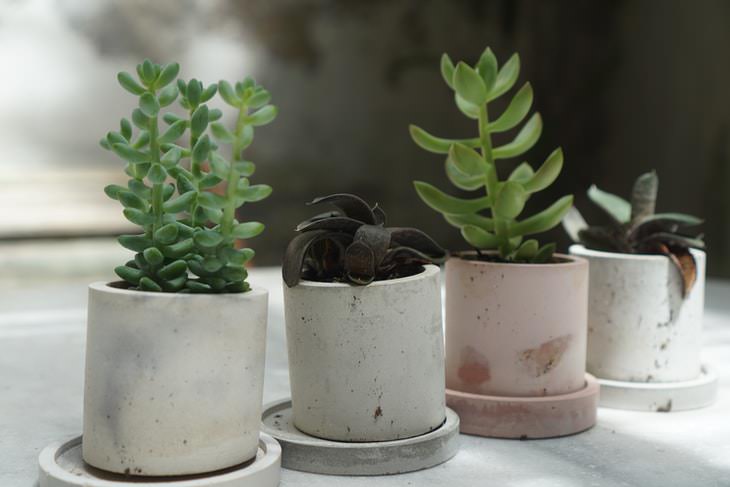
Concrete planters have been increasingly popular in the past few years. Smaller concrete pots are commonly combined with cacti or succulents, whereas large concrete planters can contain quite large trees and shrubs outdoors. Compared to terracotta, concrete is an excellent insulator and will protect the plant’s roots from extreme weather conditions. They don’t crack in cold weather and retain their look for decades.
At the same time, concrete planters are extremely heavy, and all that extra weight means that they will not work well for shelves or balconies. In addition, concrete contains lime, which is toxic to several plants. For this reason, horticulturalists recommend rinsing the pot very thoroughly several times to wash away lime deposits. Some people even recommend leaving a concrete planter empty and letting the rain wash it for several weeks prior to planting.

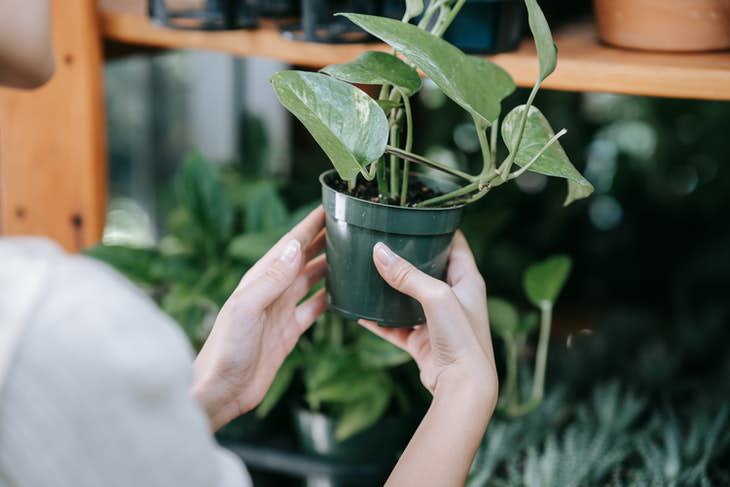
For most people, plastic planters are the most practical and affordable choice. Plastic pots are definitely the most common kind of pot you can find these days. They are easy to find in any size, color, or shape, and some can even mimic the texture of concrete, terracotta, or stone, so nothing can beat the versatility of plastic planters.
Furthermore, when you purchase higher-quality plastic pots, they are quite resilient to heat damage and cracking too, even when dropped. Also don’t forget that plastic pots are the most lightweight, which makes them very portable and suitable for practically any place in your home or outdoors - from narrow shelves to balcony or staircase railings.
Unfortunately, most cheap plastic pots are made of low-quality materials and can fade or become brittle when exposed to the sun. For this reason, look for thicker and tougher-looking plastics - they will last much longer.
Dark-colored pots, in particular, may trap heat and damage the roots, so it’s better to go for lighter colors like beige, white, or brown. There’s also the issue with the environmental impact of plastics that should not be ignored.
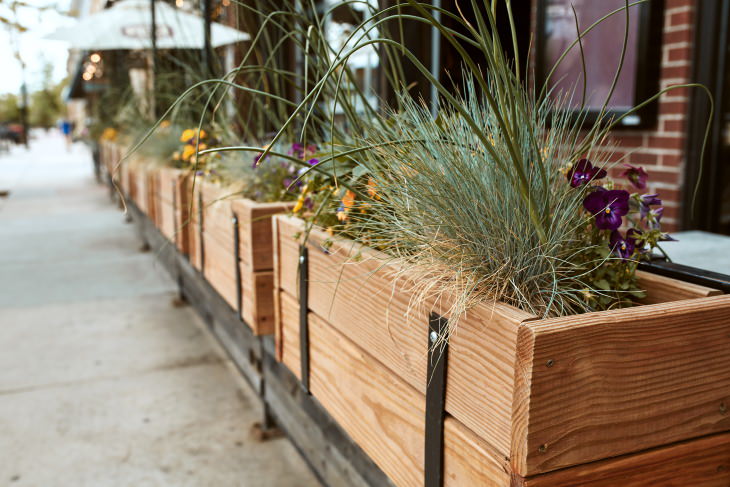
Wood is a beautiful natural material that will accentuate the natural beauty of your plants and give your home a cozy and organic feel. Old wooden boxes and crates can be reused and pot planters too, so they may be the most affordable kind of planter if you’re ready to spend a little time on a DIY project. However, wood can also be finicky and not very long-lasting. When not resealed yearly with some kind of finishing product (like oil, paint, wood stain, or a waterproofing agent), wood planters can rot or harbor pests. One must also line the inside of wooden pots with plastic film before adding soil to prevent water damage.
Apart from the materials we mentioned above, houseplants can also be grown in baskets, stone planters, or even fabric planters, but most of these containers only act as cache pots and not standalone planters, so we excluded them from our final list. We hope this guide has given you a better grasp of houseplant pots and empowered you to beautify your living spaces with indoor plants without compromising on the health and longevity of your precious plants.
Share these tips with other houseplant owners!